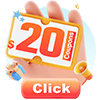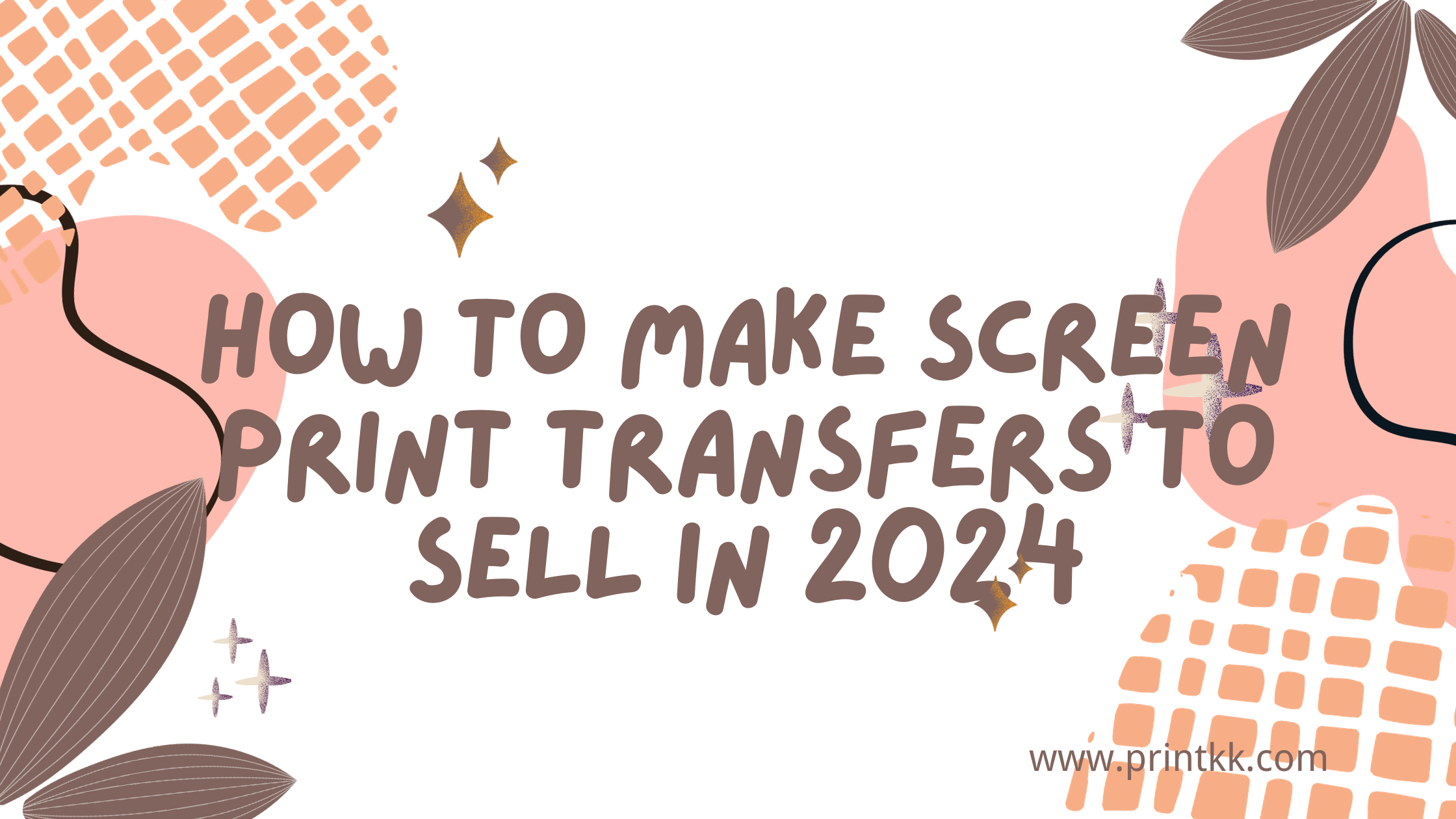
Dive into the dynamic world of print-on-demand with our essential guide on creating screen print transfers for 2024. Perfect for entrepreneurs and creatives, this guide offers step-by-step insights to elevate your merchandise with high-quality, standout prints. Embrace the future of screen printing and transform your designs into captivating, market-ready products.
What Is a Screen Print Transfer?

Struggling with blurry or fading designs on custom merchandise? Screen print transfers are the solution. This method prints your design onto special paper, which is then heat-pressed onto the product, resulting in sharp, vibrant images.
Why are screen print transfers important? They ensure your designs remain vivid and clear, even after multiple washes. Ideal for entrepreneurs, artists, and businesses of all sizes, this technique offers durability and quality in branded merchandise.
Advantages of Screen Print Transfers
In the fast-paced world of custom merchandise, screen print transfers are a top choice due to their outstanding quality, versatility, and durability. This method, which involves transferring ink from specialized paper onto a product under high heat, brings numerous advantages to the print-on-demand industry. It's particularly effective for a variety of materials, allowing for expansive creativity and design flexibility.
Screen print transfers shine in their ability to adapt to different products, from T-shirts and tote bags to custom outdoor cushions. This adaptability makes them a valuable tool for Print on Demand Companies, enabling the creation of unique, high-quality items that cater to an array of customer preferences and needs.
High-Quality Prints
Screen print transfers produce sharp, vibrant images that retain their clarity and color intensity over time, making them ideal for designs that require precision and detail.
Durability
These transfers create prints that are highly resistant to wear and tear, ensuring that the design remains intact and doesn't fade or peel, even after multiple washes.
Versatility
Suitable for various materials, screen print transfers allow for creativity and flexibility in product design, from T-shirts to tote bags, catering to the diverse needs of designers and businesses.
Cost-Effective for Bulk Orders
Economical for large orders, this method reduces per-unit cost, a significant advantage for businesses managing inventory and cost-efficiency.
Eco-Friendly Options
With advancements in technology, eco-friendly inks and materials are increasingly used in screen print transfers, appealing to environmentally conscious brands and consumers.
Materials of Screen Print Transfers
In the realm of screen print transfers, the materials used play a pivotal role in determining the quality and appeal of the final product. For entrepreneurs, designers, and businesses in the print-on-demand industry, understanding these materials is key to creating merchandise that stands out. Each component, from the type of transfer paper to the ink used, contributes significantly to the overall look, feel, and durability of the printed item. Let's dive into the core materials that make screen print transfers an excellent choice for high-quality, customized printing.
Transfer Paper
The backbone of screen printing, high-quality transfer paper ensures efficient ink transfer and impacts the clarity and longevity of the print. Different types cater to various fabric types and inks.
Screen Printing Ink


Specialized inks are used for their vibrancy and durability. They must be compatible with both the transfer paper and the product material to ensure a flawless, long-lasting print. The right choice of ink is particularly important when creating intricate designs for items like custom rugs, which are part of the expansive print on demand products category available through PrintKK.
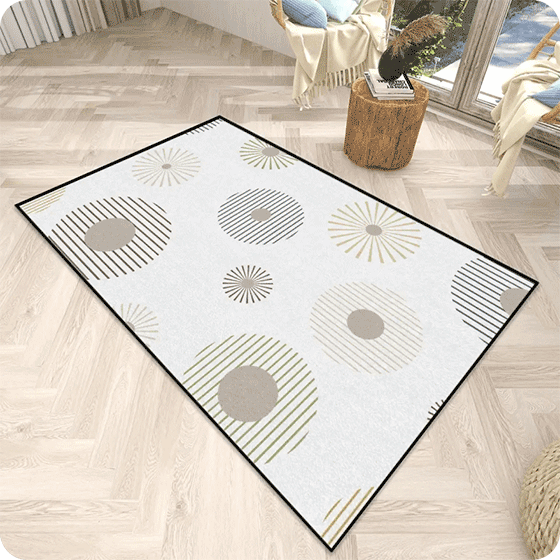
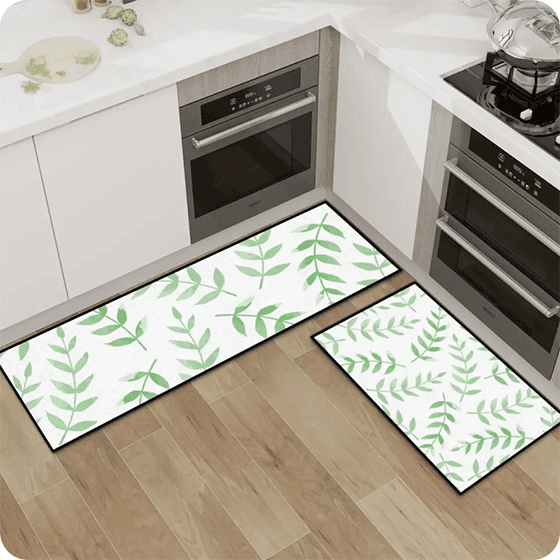
Screens
Screens in screen printing are crucial for defining the print's detail and precision. The right screen mesh count is essential for the sharpness and accuracy of the print.
Heat Press
A crucial tool, the heat press applies the necessary heat and pressure to transfer the design from the paper to the product. Its effectiveness is key to avoiding smudges and ensuring a clean transfer.
Cleaning Agents
Maintaining the quality of the screens and equipment is vital. Proper cleaning agents help in prolonging the life of the materials and ensuring consistent print quality.
How to Make Screen Print Transfers?

Creating screen print transfers may seem daunting, but it's a process that, when mastered, can elevate the quality of your custom merchandise significantly. This technique is vital for entrepreneurs, designers, and businesses seeking to produce high-quality, durable, and visually striking products. The key lies in understanding and following each step carefully, ensuring that your designs translate perfectly from concept to final product.
Design Preparation
Begin by preparing your design digitally. Ensure it's high-resolution and correctly formatted for screen printing. This step is crucial for achieving sharp and clear prints.
Transfer Paper Selection
Choose the right type of transfer paper for your fabric. Different materials require different papers to achieve the best results.
Ink and Screen Setup
Use screen printing ink that complements your design and fabric type. Set up your screen meticulously, ensuring it's tightly secured and free of any defects.
Printing the Design
Print your design onto the transfer paper using the screen. This requires precision to ensure the design is accurately replicated on the paper.
Transferring to the Product
Place the printed transfer paper onto the product. Use a heat press to apply heat and pressure, transferring the ink from the paper to the product.
Curing and Quality Check
After transferring, cure the print to set the ink. This step is vital for durability. Finally, conduct a quality check to ensure the print meets your standards.
How to Make Full Color Screen Print Transfers?
Creating full color screen print transfers is a blend of art and precision, essential for producing vibrant, detailed designs on merchandise. This skill is particularly valuable for anyone in the print-on-demand sector looking to make their products stand out. The process involves several steps, each crucial to achieving the perfect balance of color, clarity, and durability. Here's a comprehensive guide to mastering full color screen print transfers, ensuring your designs capture attention and last long.
Design Preparation
Start with a high-resolution, full-color design. Separate it into different color layers for screen printing.
Screen Selection
Choose screens with appropriate mesh counts for each color. Finer meshes work best for detailed and lighter colors.
Screen and Ink Preparation
Prepare each screen with its corresponding color. Use quality screen printing inks suitable for your fabric type.
Sequential Printing
Print each color layer one after the other, allowing drying time in between. This step is crucial for color accuracy and clarity.
With each layer carefully printed, your full-color design will come to life, ready to enhance a diverse array of products including custom canvas prints and wall art, a staple in the PrintKK's selection of customizable items.
Alignment Accuracy
Regularly check the alignment of each color layer to prevent misprints and ensure sharp imagery.
Heat Pressing
After all layers are printed, use a heat press to transfer the design onto the product. Precise temperature and pressure settings are key.
Curing and Quality Check
Finally, cure the print for durability and conduct a thorough quality check for color fidelity and overall appearance.
How to Choose a Screen Print Transfer Vendor?
Selecting the right screen print transfer vendor is crucial for success in the print-on-demand industry. Your choice directly impacts product quality and customer satisfaction. This guide focuses on key considerations for finding a vendor that meets your quality expectations and business needs, ensuring top-notch screen print transfers.
Factors to Consider When Choosing a Screen Print Transfer Vendor
- Quality of Transfers: Assess the quality of the vendor's screen print transfers. Look for clarity, color accuracy, and durability in their samples. High-quality prints are essential for maintaining a professional image.
- Material Compatibility: Ensure the vendor offers transfer options compatible with a variety of materials. This flexibility is key for businesses that print on diverse products.
- Customization Options: A good vendor should provide ample customization options, allowing you to tailor prints to specific designs, colors, and sizes.
- Turnaround Time: Consider the vendor's production and delivery times. A vendor with a quick turnaround can be crucial for meeting tight deadlines and maintaining a steady flow of products.
- Pricing Structure: Analyze their pricing to ensure it aligns with your budget and offers value for money. Competitive pricing without compromising on quality is important for cost-effective operations.
- Customer Support and Service: Good customer service is vital. Look for a vendor that offers excellent support, provides clear communication, and is responsive to your needs.
- Reputation and Reviews: Research the vendor's reputation. Customer reviews and testimonials can give insight into their reliability and the quality of their work.
- Technology and Innovation: A vendor using the latest technology and innovative techniques can offer superior prints and more options, keeping you ahead in a competitive market.
Tips for a Successful Screen Print Transfer
Mastering screen print transfers is essential for producing top-quality custom merchandise. This process, pivotal for those in the print-on-demand industry, requires attention to detail and adherence to best practices. The tips provided here are tailored to help you achieve vibrant, durable prints, enhancing the appeal and longevity of your products.
- Design Optimization: Start with a high-quality, high-resolution design. Ensure it's suitable for screen printing and consider how colors and details will transfer onto your chosen material.
- Right Choice of Materials: Select the appropriate transfer paper and inks for your specific fabric type. Compatibility between materials is crucial for optimal print quality.
- Screen Mesh Selection: Choose the right mesh count for your screen. Different designs require different mesh counts for clarity and detail accuracy.
- Precise Ink Application: Apply ink evenly and carefully. Consistency is key to avoiding blotches or uneven prints.
- Proper Heat and Pressure: During transfer, use the correct heat and pressure settings. This varies depending on the fabric and ink types, and is vital for a successful transfer.
- Test Prints: Always do test prints before starting a large batch. This helps identify any issues with the design or the transfer process.
- Regular Maintenance of Equipment: Keep your screens and heat press clean and in good condition. Regular maintenance prevents issues and ensures consistent quality.
- Stay Updated with Techniques: Keep abreast of the latest screen printing techniques and materials. Continuous learning helps improve your skills and the quality of your prints. By staying informed about the latest trends and techniques, you can ensure that your products, such as DIY painting supplies and home lighting fixtures, meet the highest standards of quality, just as PrintKK does.
- Quality Checks: After printing, conduct thorough quality checks. This ensures each print meets your standards and is ready for your customers.
- Client Feedback: Listen to feedback from clients and customers. Their insights can guide improvements and new ideas for future projects.
How to Sell Screen Print Transfers?
Selling screen print transfers effectively is crucial in the competitive print-on-demand market. This requires not only creating quality prints but also strategically marketing them to your target audience. This guide offers essential tips for entrepreneurs and business owners in the industry to successfully sell their screen print transfers.
- Understand Your Audience: Identify and understand your target customers to tailor your designs and marketing efforts.
- Quality is Key: High-quality prints attract more customers and encourage repeat business.
- Effective Online Presence: Utilize a well-designed website, social media, and online marketplaces to showcase your products.
- Utilize SEO Strategies: Implement SEO best practices to increase online visibility.
- Leverage Social Media: Engage with your audience on social media platforms through regular posts and interactive content.
- Offer Customization: Provide customization options to appeal to a wider audience.
- Competitive Pricing: Research market prices and set competitive rates.
- Customer Service Excellence: Ensure prompt and effective responses to customer inquiries and issues.
- Partnerships and Collaborations: Collaborate with influencers, artists, and brands to reach new audiences.
- Feedback and Improvement: Use customer feedback to continually improve your products and services.
Conclusion
In conclusion, mastering screen print transfers is a blend of artistry and precision. This blog has provided essential insights for those in the print-on-demand industry, covering everything from material selection to effective selling strategies.
Key takeaways include the importance of understanding your audience, maintaining high quality in prints, and staying adaptable to industry changes. These elements are vital for anyone looking to excel in screen printing, from entrepreneurs to established businesses.
As you continue your journey in screen printing, remember the value of innovation and continuous learning. These insights are just the beginning, paving the way for your success in creating captivating and enduring screen print transfers. Happy printing!
FAQs
How to make screen print transfers at home?
Creating screen print transfers at home involves printing a high-resolution design onto transfer paper, applying screen printing ink to a prepared screen, and then using a heat press to transfer the design onto fabric. Ensure correct heat and pressure settings for optimal results. This process allows for the production of quality screen prints in a home setting.
Can you make your own screen print transfers?
Yes, you can make your own screen print transfers. The process involves creating a design, printing it onto special transfer paper, and then using a screen and ink to apply the design. Finally, transfer the print to your chosen material using a heat press. This DIY approach is great for customizing a variety of products at home or in a small business setting.
What is used to make screen print transfers?
To make screen print transfers, essential items include high-resolution design artwork, specialized transfer paper, screen printing inks, a squeegee for ink application, screens for each color in the design, and a heat press. These materials work together to create vibrant, high-quality transfers suitable for a variety of fabrics, catering to businesses and creative individuals alike.


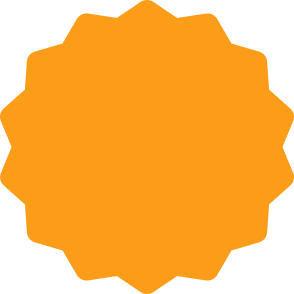




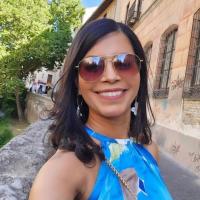


 Global Shipping
Global Shipping





























